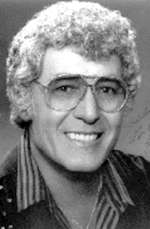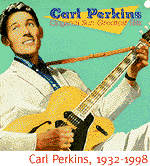
Carl Perkins Takes His Shoes And His Music To Rock Heaven.
By Gregory McNamee - Jan 22, 1998
TWENTY YEARS AGO, an English reporter asked Carl Perkins, who was then in London promoting his new album Old Blue Suede's Back, how many times he had performed his signature tune "Blue Suede Shoes." He didn't rightly know, Perkins replied, with a hint of a grimace crossing his face. He'd lost count, he continued, after the first couple of thousand.
 It's understandable that Perkins, who died on January 19 at the
age of 65, harbored mixed emotions about the song that made him
famous. It wasn't his favorite song, not by a long shot. Neither
was it his best song. (For its memorable economy alone, I'd give
that honor to "Honey Don't.") "Blue Suede Shoes"
had a complicated history, too. Not long after its 1956 release,
which sold 2 million copies and topped the pop-music charts, Perkins
suffered an auto accident that sidelined him for months and left
his brother dead. While Perkins recovered, Elvis Presley, his
label-mate at Sun Records, released a version that sold even more
copies and certified Presley's stardom.
It's understandable that Perkins, who died on January 19 at the
age of 65, harbored mixed emotions about the song that made him
famous. It wasn't his favorite song, not by a long shot. Neither
was it his best song. (For its memorable economy alone, I'd give
that honor to "Honey Don't.") "Blue Suede Shoes"
had a complicated history, too. Not long after its 1956 release,
which sold 2 million copies and topped the pop-music charts, Perkins
suffered an auto accident that sidelined him for months and left
his brother dead. While Perkins recovered, Elvis Presley, his
label-mate at Sun Records, released a version that sold even more
copies and certified Presley's stardom.
Perkins never hit the top rank of pop performers, although he nearly single-handedly invented the rockabilly idiom that made Elvis the king. (Elvis copped a few of Perkins' infamous pelvic gyrations, too, but Perkins never complained.) And although he wrote dozens of songs, it was "Blue Suede Shoes" for which he was remembered, always "Blue Suede Shoes" that he was called on to perform on oldies tours and television specials. He kept a good humor about it, ever the gold-chained country gentleman, insisting that the song really ought to be titled "Blue Swade Shoes." "That's how I wrote it the first time," he said. "I still think s-u-e-d-e don't spell 'suede.' "
 He also added that he owed the inspiration for his song to his
friend Johnny Cash, another rising star at Sun, who pointed out
a fellow dressed in odd footwear at a barn dance. "I don't
know nothin' about no shoes," Perkins said to Cash, but a
day or two later he had created a song that would earn him countless
fans--not least of them George Harrison of The Beatles, who helped
arrange English tours for Perkins and who co-produced his 1986
comeback special, a remarkable musical documentary called Carl
Perkins and Friends. (The Beatles also recorded five of Perkins'
songs.)
He also added that he owed the inspiration for his song to his
friend Johnny Cash, another rising star at Sun, who pointed out
a fellow dressed in odd footwear at a barn dance. "I don't
know nothin' about no shoes," Perkins said to Cash, but a
day or two later he had created a song that would earn him countless
fans--not least of them George Harrison of The Beatles, who helped
arrange English tours for Perkins and who co-produced his 1986
comeback special, a remarkable musical documentary called Carl
Perkins and Friends. (The Beatles also recorded five of Perkins'
songs.)
Perkins was the real chitlins, a man who had a native son's right to sing the blues hidden deep within rockabilly's swagger. He was born in a tiny farm town in western Tennessee, in the Delta country that produced Muddy Waters, Willie Dixon, Robert Johnson, Johnny Cash, and, yes, Elvis. Put to work in the cotton fields at age 6, Perkins learned the blues shouts of his African American neighbors. One of them, he recalled, made a sort of guitar for him out of a cigar box and a broom handle, and from then on he was hooked, playing in roadhouses and honkytonks for a few cents in tips. He formed a strange hybrid style of playing during those years, incorporating elements of the blues, Appalachian folk music, gospel, and Grand Ole Opry country, the music of his daily life. Someone somewhere along the line coined the term "rockabilly" to embrace Perkins' sound and that of like-minded Delta-region musicians.
 Perkins, however, always said that he and his brother just called
what they played "good-time music." He elaborated, "That's
what rockabilly music, or rock 'n' roll was to begin with, a country
man's song with a black man's rhythm. I just put a little speed
into some of the slow blues licks." That speed made him a
guitarist's favorite--Keith Richards, Mark Knopfler, John Fogerty,
Bonnie Raitt, and George Harrison have all cited Perkins as a
major influence--but it didn't do as much as Perkins hoped to
pay the bills. By the late 1950s, with Elvis in the army, Chuck
Berry in jail, and Buddy Holly dead, the rockabilly-hybrid sound
had given way to inoffensive tunes by clean-cut crooners like
Pat Boone and Bobby Darin. Perkins held to rockabilly for a few
years, but he eventually switched over to a more radio-friendly
country sound. Even then stardom eluded him. Still, he said, his
ability to pick a guitar at least earned him enough to keep him
out of the cotton fields.
Perkins, however, always said that he and his brother just called
what they played "good-time music." He elaborated, "That's
what rockabilly music, or rock 'n' roll was to begin with, a country
man's song with a black man's rhythm. I just put a little speed
into some of the slow blues licks." That speed made him a
guitarist's favorite--Keith Richards, Mark Knopfler, John Fogerty,
Bonnie Raitt, and George Harrison have all cited Perkins as a
major influence--but it didn't do as much as Perkins hoped to
pay the bills. By the late 1950s, with Elvis in the army, Chuck
Berry in jail, and Buddy Holly dead, the rockabilly-hybrid sound
had given way to inoffensive tunes by clean-cut crooners like
Pat Boone and Bobby Darin. Perkins held to rockabilly for a few
years, but he eventually switched over to a more radio-friendly
country sound. Even then stardom eluded him. Still, he said, his
ability to pick a guitar at least earned him enough to keep him
out of the cotton fields.
By the time of his death, following complications from a series of strokes, Perkins had attained the status of rock-and-roll senior statesman, invited to lecture at universities and give keynote speeches at gatherings like the 1997 South by Southwest Music and Media Conference at Austin. He had recently recorded an album, Go Cat Go!, that showcased an unlikely mix of acolytes, including Tom Petty & The Heartbreakers, Paul Simon, Willie Nelson, Ringo Starr, Paul McCartney, and the ubiquitous Bono. In one of his last appearances, the September 1997 benefit concert for the volcano-ravaged Caribbean island of Montserrat, he earned a standing ovation after sharing the stage with McCartney, Eric Clapton, Elton John, Sting, and assorted other members of rock royalty.
The tune he played, of course, was "Blue Suede Shoes."